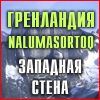|
 Interviewed
by Anna Piunova, Mountain.RU Interviewed
by Anna Piunova, Mountain.RU
Translated by Anna Samodelko, Mountain.RU
Timur Ahmedhanov and
"the Russian Extreme project " in Greenland
Interview for Mountain.RU
Part 2
The category of difficulty
Timur Akhmedkhanov (T.A.): The first two
pitches via Swedish route were simple, probably À2, but that we climbed
two cornices there. Then we went on our original variant of the route
which appeared more direct, than Swedish. We did not bolt the route. But
it seems I tell lies: there was a pair of places where we bolted... But,
in general, the route turned out logical adhered to a natural relief,
cracks and splits. Basically, probably, you can ascend by free climbing.
If we somehow try to estimate it, that, certainly, it is very uneasy for
free climbing. To tell the truth, it isn't insecure for climbing with
belay. From the point of view of aid climbing its category I would estimate
as À4. As we have the experience for comparison according the El-Cap measures
there was one pitch of À4 exactly. On the average, I would estimate as
À2/À3. Its speciality is that the route is very equable. You have to work
on every its site. Somewhere you can find a good crack, somewhere it is
worse. We had to beat out holes under skyhooks and to traverse for about
4 meters in two places using skyhooks. The first traverse Alexander climbed
as a leader, and I obtained the second one and made some holes in it.
The crux of the end of the traverse is back-cleaning, a work when you
have to take out the devices behind your to avoid a big bend. Both sites
were very strained and demanded our concentration and attentiveness.
The Equipment
As it seemed to me, that the steel bolts work better
than titanium ones there. We normally managed to bolt the steel ones,
but they frequently took off, did not hold. It depends on the stratum.
Climbing the Wall we worked with friends: big ones, camalots, and small
ones, we had ellings. The camalots often facilitated our task. The stoppers
worked excellent. The belay, basically, was based on friends.
The Sensations
On sensations, the cracks there remind Crimean ones
very much. By comparison with El-Cap ones, completely with straight lines
and smooth edges, they have more variety of a surface, therefore it we
had to harder work with friends than with stoppers. Arcady and I worked
using etriers. This year I have completely refused of using hook-leg-ladders
and hook-leg-pro. There is a new fashion now. That damned Americans set
the tone againJ - To use hook-leg-ladders is less sports and less
convenient for a combination of aid- and free-climbing. It is more difficult
to change the style of climbing: with aid- to free and back using it.
Using simple rag etriers it appears easier. I guess, that it was pleasant
to me: they are big, are not get tangled, you are able to hang out some
gear on it, and the techniques does not strongly differ from hook-leg-one,
you can stretch and reach. Valery Rozov and Alexander Lastochkin worked
still using hook-leg-ladders, and swore terribly on me for my etriers.
But Alex and I are the universal two, with the identical size of a foot,
the same hook-leg-ladder and many other things. To take skyhooks and to
hang it on a bunch requires the additional work
B.A.S.E.
In my opinion very skilled people produce portaledges
L5. And accordingly that, if they claim that the platform is reckoned
for two person, that so it is, and it is not reckoned for six clambered
up. Naturally, it did not hold us. There were six of us moving on it and
preparing to Valery's jump. Certainly, we tried to not load the portaledge,
but, eventually, we all won it, and one rack broke. It just bent. For
the first moment, of course we were impressed. There was a minute of silence.
What could we do? The opportunity of a jump was going to be missed. But
that moment I looked with horror at Valerie's eyes and understood, that
he would jump in any case though from the broken portaledge, though from
our hands, though from a trunk... He at once started to search any convenient
variant; he had already made up his mind. Though thus it was obvious to
everyone, that he was nervous. Finally everything turned out. Having sat
dumbfounded, but in result we recollected about ice screws. We crammed
it into the rack, winded round. We had to fold the portaledge removing
one sector and shortening the transverse size and just propped it up a
shoulder to give to this construction any stability. Valery was difficult
to jump, probably, all had happened we perceived as a certain hint, the
sign not to jump... But he came off, pushed with the longest and, probably,
the weakest rack (though it wasn't broken)... It has already spoken much
about the impressions. Adrenaline emission is incomparable. There is a
rule at a level of a reflex in climbing: you have to climb constantly
roped. But when he undresses, removes his harness, simply stands at edge
- hell's bells! And when he jumps, certainly, you feel some pleasant excitation
in a combination to unpleasant ideas that it is necessary to us to climb
further. To the best of my knowledge, the first step, the push is very
important for B.A.S.E. jumping. It is the foundation of everything. If
something happens but jumper has not received an initial, horizontal component,
he can fly very close to a wall.... If he get in a stream, there is everything
normal. Then Rozov flu away departed, caught a stream... We could hear
only a sound, and that was all.
<< Part
1 Part 3 >>
|

